





The Bullet Holes at the Westgate Hotel
By Ray Stroud and Olly Blackmore
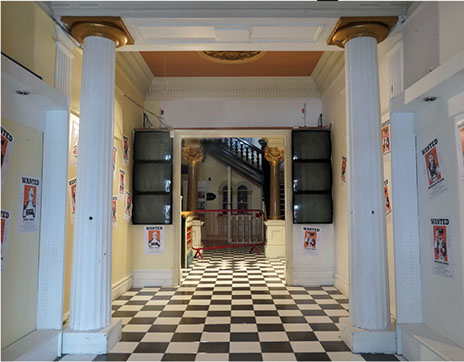
In November 1839, Westgate Square was the site of the Newport Uprising, where more than twenty men were shot dead by soldiers of the 45th of Foot. For many years the famous holes in the pillars of the old hotel were unquestioningly accredited to bullets or musket balls used in the exchange of fire during this event. Newport City Councillor, David Mayer, Web editor of Chartism eMagazine, recalls that when he was 8 years old his father, from Abersychan, took him to the Westgate where he poked his fingers into the Chartist bullet holes. For many, writes Newport Historian, Les James, “this practice was a rite of passage for Newport citizens.”
During 1970s however some people began to suggest that the holes were drilled into the pillars to make fixings for doors, gates or railings. Others claimed that the columns were made of metal much later and that the holes had nothing to do with the Newport Rising of 1839.
In March 2010, A. N. Coward, of the Royal Commission on Ancient and Historical Monuments of Wales wrote:
“ In November 1839, the previous hotel was the site of the Newport Uprising, when more than twenty men were shot dead. According to tradition, holes in the porch columns were caused by Chartist bullets, but this seems unlikely as the present hotel was not in existence at the time.".
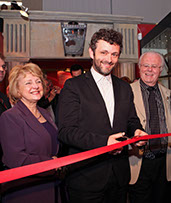
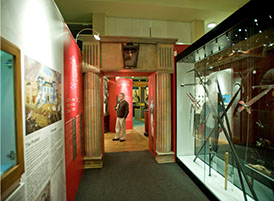 In 2010 Newport born Hollywood actor Michael Sheen and his parents opened the new Chartism exhibition at the Museum and Art Gallery in John Frost Square. Comments were made by local Chartist historians about the “missing” bullet holes in the reconstructed columns from the Westgate Hotel. Gradually the “fake” story became accepted by a new generation of Newportonians and so the debate continued until recently.
In 2010 Newport born Hollywood actor Michael Sheen and his parents opened the new Chartism exhibition at the Museum and Art Gallery in John Frost Square. Comments were made by local Chartist historians about the “missing” bullet holes in the reconstructed columns from the Westgate Hotel. Gradually the “fake” story became accepted by a new generation of Newportonians and so the debate continued until recently.
Our Chartist Heritage have been using the Westgate in recent years for a variety of Chartism related events under the banner of Newport Rising. This includes the marvellous, now annual Torch Light March that traces the 1839 route from Belle Vue Park, down Stow Hill to the Westgate Hotel.
Most of the older participants were raised on the belief that the bullet holes were real. Many of the younger marchers knew only the current opinion as expressed by official sources such as Dr. Coward (above). Were the bullet holes real or fake? Soon a plethora of contemporary evidence was cited for and against the authenticity of the bullet holes.
It was decided that a full investigation was needed that brought together the historical evidence. Newport Historian Ray Stroud would investigate the historical sources. And Newport Museum's Olly Blackmore would investigate the physical remains.
Part one: The Historical Evidence
by Ray Stroud
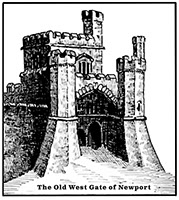 The Westgate Hotel at the time of the rising was built in 1779 on the site of the West Gate of the town’s fortifications.
The Westgate Hotel at the time of the rising was built in 1779 on the site of the West Gate of the town’s fortifications.
In 1837 Samuel T. Hallen became the owner. Kelly’s Newport Directory of 1848 describes Hallen as an ‘Innkeeper, Livery Stable Keeper, Postmaster and Patent Hearse Proprietor.
In the same 1848 Directory they used the famous Mullock print (below) as the main image.
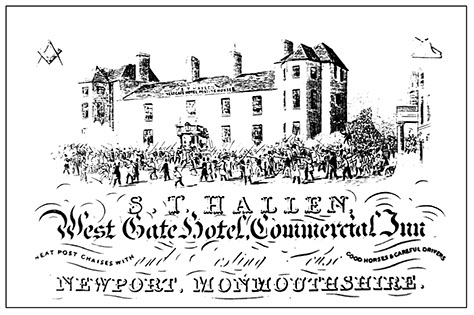
During the late-Victorian era, Chartism continued to fascinate the inhabitants of Newport, and artefacts from the Rising were able to command a strong a commercial value.
In February 1884, the Star of Gwent began to carry a series of articles entitled, ‘The Westgate Hotel and the Chartist Riots’. Interestingly too, in August 1885, the Star listed an inventory of historical objects that had been loaned to the temporary museum. These, stated the newspaper, gave evidence of ‘a local possession of rich antiquities, which many counties of greater pretensions might well be proud of.’ Listed amongst the Roman coins and Lady Byron’s toilet boxes, were ‘two bits of lead removed from the head of Sergeant Daley, wounded at the Westgate.’
Despite the passing of the Third Reform Act in December 1884, the Chartist Movement was still widely viewed with contempt. The South Wales Daily News and the Cardiff Times, for example, both wrote of, ‘… the Westgate Hotel, round which lingers the odour of misguided Chartism …’
They felt that,
"The Newport of olden days is disappearing beneath the spade and the shovel of the re-constructor, whilst at the same time the borders of the borough are continually extending outwards … the Westgate Hotel, round which lingers the odour of misguided Chartism, is being shorn of everything it contains, prior to demolition and the erection on the site of a building more in consonance with the requirements of modern, social and commercial life … "
At the beginning of 1884, the Westgate Hotel Company was formed to take over the business of the hotel and to re-build the premises. It was envisaged that the new company would take possession of the property by April 1884, with a programme of demolition planned. The promoters intended that, ‘it shall be a first-class hostelry and supply a want greatly felt.’ A block plan, which involved widening Stow Hill, was submitted to the council in March and was approved without reservations. There was ‘a unanimous expression of opinion that, when carried out, a great improvement would be effected.’
On Monday 31 March 1884, a luncheon was held to mark the virtual closing of the old Westgate Hotel. Among the company were the Mayor, ex-Mayor, Aldermen Beynon and Murphy, Councillor Fothergill and other leading townsmen. The toast of “Success to Newport Hotel Company” was proposed by the Mayor. … Beynon … returned thanks … remarking that the company hoped to put up a building which could not be equalled in South Wales.
It was intended that the building would be ready for furnishing by December 1885 and would be run by Mr Samuel Dean of the Castle Inn, Commercial Road. It appears that Dean had arrived in Newport from Wiltshire in 1855, to work at the Castle Inn for his uncle, William Salisbury. It is believed that he had boarded the steam packet ‘Welsh Prince’ with a desire to know more about the Chartist attack on the Westgate.
The new Westgate Hotel, which was leased to Dean for a period of twenty-one years, eventually began to reveal some of its secrets to him.
He recorded that,
"In excavating underneath the old (Chartist) Westgate Hotel, preparing for the foundations of the present building, the workmen came across an old spiral stairway, and at the bottom a stone porch, forming the entrance into a subterraneous passage or subway, was discovered, leading under the road (Stow Hill) in the direction of Messrs. Smith's property. The contractor being satisfied did not proceed further, and the place was filled in."
The discovery of ‘another fragment of the old west gate of the town’ was to prove captivating for the press in South Wales. A number of artefacts had been found, such as a ’mutilated silver penny’. The demolition of the old building had already begun on Tuesday 27 May, with the stone archway and spiral stone steps being discovered some weeks later. These steps appear to have led to a guardroom below. Although both the arch and staircase were subsequently removed, they were preserved by the architect. They were later photographed and inspected by a group of gentlemen, including Octavius Morgan, who was a keen antiquarian.
Yet not everything was destroyed. Visitors to the new hotel were to be informed that a number of cases of interesting ‘curios’ and mementoes of the Chartist riots, including some of the pikes used by the Chartists, were to be found in the corridors. It was also decided that, in the vestibule,
‘the bullet-pierced pillars of Chartist memory will receive a place of honour, and will be a sufficient contrast to the rest of the fittings to attract attention’.
One of the last major events held at the old Westgate was a fashionably-attended ‘calico’ or fancy-dress ball. The Monmouthshire Merlin reported that, ‘dancing took place in the coffee room which was effectively decorated for the occasion’.
The foundation stone for the new hotel was laid on the afternoon of Monday 21 July 1884 by Mr E. J. Grice, vice-chairman of the Westgate Hotel Company. It was originally intended that this task would be performed by Mr Crawshaw Bailey (called away to London).
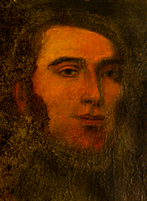 In April 1884, a four-day sale of ‘furniture and effects’ took place at the hotel before the demolition commenced. The South Wales Daily News reported that many of the contents of the old building had been auctioned at a ‘sale of curiosities’ in the Westgate. The Newport Free Library Committee decided to bid for two items relating to the Chartist Rising. Having failed in its bid for a Chartist pike, the Library successfully acquired an oil painting of Lieutenant Basil Gray (left) ‒ the man who had commanded the foot soldiers from the 45th Regiment inside the Westgate during the Newport Rising. It seems that the portrait was purchased anonymously for £21, ‘after keen competition’ and was later presented to the Free Library. This painting remained in the art collections of the Free Library; it is now in storage, awaiting restoration at Newport Museum and Art Gallery.
In April 1884, a four-day sale of ‘furniture and effects’ took place at the hotel before the demolition commenced. The South Wales Daily News reported that many of the contents of the old building had been auctioned at a ‘sale of curiosities’ in the Westgate. The Newport Free Library Committee decided to bid for two items relating to the Chartist Rising. Having failed in its bid for a Chartist pike, the Library successfully acquired an oil painting of Lieutenant Basil Gray (left) ‒ the man who had commanded the foot soldiers from the 45th Regiment inside the Westgate during the Newport Rising. It seems that the portrait was purchased anonymously for £21, ‘after keen competition’ and was later presented to the Free Library. This painting remained in the art collections of the Free Library; it is now in storage, awaiting restoration at Newport Museum and Art Gallery.
The pike was bought by Thomas Phillips Price of Triley Court, the nephew of the late Sir Thomas Phillips, the mayor of Newport in 1839, for ten guineas.
The Bullet Holes
Until very recently it was accepted without question that the pillars in the foyer of the new Westgate Hotel were the original artefacts from 1839. Since that time many generations have viewed the holes in the pillars accredited to bullets or musket balls used in the exchange of fire during the Newport Rising. The popularity of the columns prompted the developers of the new hotel to retain them in the new building.
However, as mentioned above, during the 1970s doubt began to be sown about the authenticity of the bullet holes. One local historian wrote,
Many people believe that the holes in metal columns near the entrance to the building are bullet holes left after the attack. Sadly, this is not true and the holes appear to be for railings to be attached.
For some reason the ‘railings position’ has been sufficient for older histories of the Newport Rising, such as the one provided by W. N. Johns, to be questioned, if not entirely dismissed, by some modern historians. However, contemporary newspaper reports are quite clear about the issue.
The original portico was taken down on Wednesday 17 September1884. The Monmouthshire Merlin reported on 19 September that,
‘… in the pillar that suffered the most on the occasion of the Chartist riots the workmen came across several roughly-made bullets, one with a nail driven through the centre of it.’ The newspaper added that, ‘…the bullets have doubtless lain where they were found ever since the memorable attack on the hotel 45 years ago.’
Three days later the Weekly Mail confirmed that, in one of the pillars, three bullets had been found.
In his book, The Chartist Riots at Newport: November 1839, which was published in 1889, W.N. Johns confirms that,
On the removal of the wood pillars which supported the porch front of the Old Westgate on 17 September 1884, there were found four roughly-made bullets or slugs, which had evidently lain in the interior of the pillars since the day of the attack on the building ‒ forty-five years before.
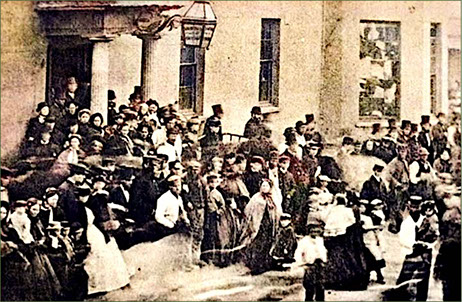
The earliest photograph we have of the pillars is unfortunately overcrowded with onlookers but in other contemporary images the musket ball holes are clearly visible.
In a newspaper article of 1879, the columnist ‘Morien’ records that his friend was,
‘. . . in the thick of the fray in front of the Westgate Hotel, the pillars of the porch of which still bear traces to this day of the bullets of the rioters ...’
This article was written nearly five years before the demolition of the old Westgate and indicates strongly that they were in existence during the years 1839 to 1884.
The musket ball holes can be seen in a lithograph of Westgate Square produced by E.H. Buckler nearly twenty years earlier, in 1860.
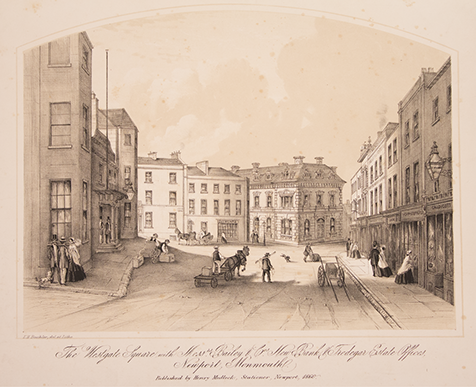
The bullet holes can be clearly seen in this close-up of the Buckler print of 1860.
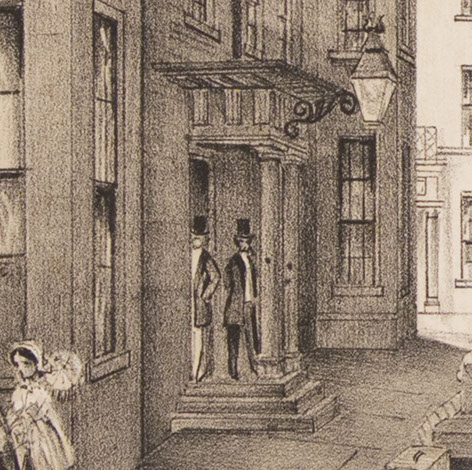 The pillars were originally located outside the entrance door, and it seems they may have been rotated when re-erected on the inside of the new building. All of this suggests that the pillars were in the direct line of fire in 1839 ‒ of both the soldiers of the 45th and the Chartists, and still bear the scars of what was ‘visible where bullets, slugs, &c., have injured the premises.’
The pillars were originally located outside the entrance door, and it seems they may have been rotated when re-erected on the inside of the new building. All of this suggests that the pillars were in the direct line of fire in 1839 ‒ of both the soldiers of the 45th and the Chartists, and still bear the scars of what was ‘visible where bullets, slugs, &c., have injured the premises.’
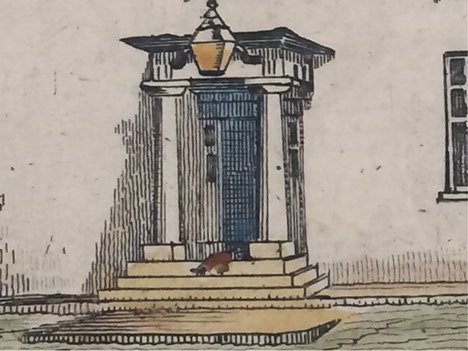
The historical evidence appears to suggest, then, that the musket holes are real ‒and that Johns had, in fact, accurately described what had taken place five years earlier. Both he, and the newspaper accounts from the 1880s, would seem to be correct.
Part Two:The Forensic investigation
Olly Blackmore
A preliminary visit to the Westgate Hotel with Newport Museum and Heritage Service’s Dr Toby Jones(below) raised questions about the railing hole theory. A keen hunter and gun enthusiast, Toby suggested the holes could very well be made by musket balls. However, expert analysis would be required to confirm this.

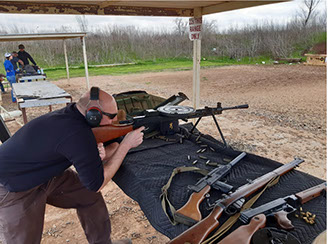
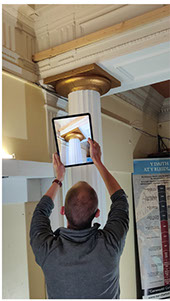 Newport Museum and Heritage Service commissioned Ross Cook (left) a building archaeologist to undertake photogrammetry, photographic and endoscope surveys, He produced an accurately drawn record of both columns.
Newport Museum and Heritage Service commissioned Ross Cook (left) a building archaeologist to undertake photogrammetry, photographic and endoscope surveys, He produced an accurately drawn record of both columns.
Photogrammetry is the science and technology of obtaining reliable information about physical objects, through the process of recording and interpreting photographic images.
The single set of holes in Column One were called A1 and A2 and the double set in Column Two, called B1 and B2 and C1 and C2
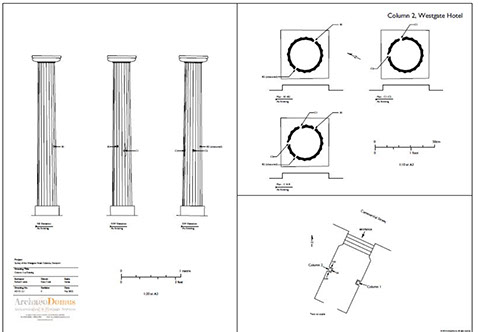
A number of issues proved problematic from a forensic point of view. The was a visible sheen on the interior surfaces of holes A1 and C1 caused by fingers (such as Councillor Mayer’s) over the last 183 years.
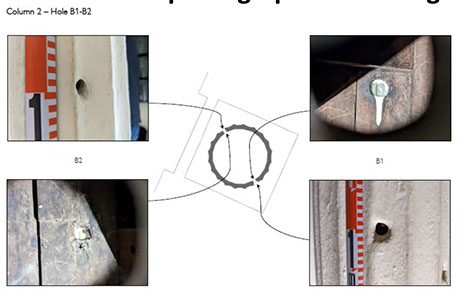
There were also paint drips caused by keen decorators anxious to maintain the appearance of the Hotel’s most popular attraction.
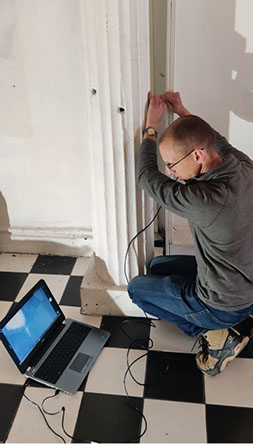
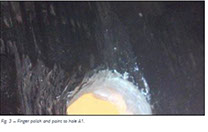
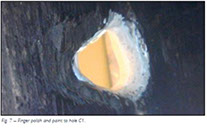
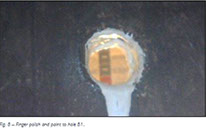
The next expert was Jonathon Ferguson, (below) Keeper of Firearms and Artillery at the Royal Armouries who provided information about the type of weapon and munitions used in the mid 19th Century.
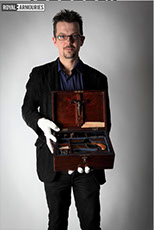
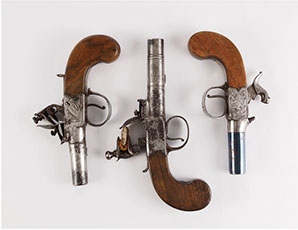
We were extremely fortunate to secure the services of Andre De Villiers Horne - one of Britain’s top forensic ballistics experts. The images presented to him were not conclusive. Andre visited the scene and tested for a “bullet wipe”.
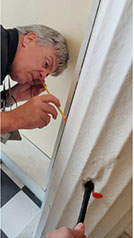
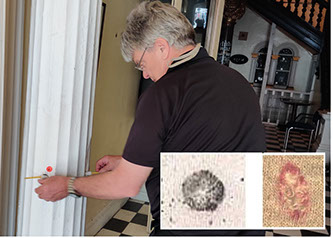
This is a test that demonstrates if the holes were actually made by lead shot. When a bullet is fired through an object, it leaves a layer of lead on surface it passes through. In July 2022 swabs saturated with acetic acid, in which lead is soluble were used to take samples from the inside of each hole. When lead is dipped in a solution of sodium rhodizonate, the lead will turn bright pink (photo above right)
The holes were again photographed and lines of trajectory, were recorded via a probe. The bullet wipe results were disappointing. Although they did produce a positive result for lead, the results were too weak to be conclusive. It is considered to be understandable that after 180 years of finger poking and repainting that the lead is no longer detectable.
The physical evidence however was better.
Andre’s report stated:
There are many unknowns – type, calibre and construction of musket balls in use by both parties at the time being the most important for me. Furthermore, the moisture content of the wood and what the columns may have been covered with at the time can be important.
It appears that we have three sets of holes. Each set aligns to form a trajectory and the apparent entry and exit holes are at approximately the same height. Although holes A1 and A2 are not perfectly aligned, this may have been the result of bullet deflection as a result of striking the column at an angle. The sets being at the same height and aligned, provides strong support for the proposition that they are bullet holes.
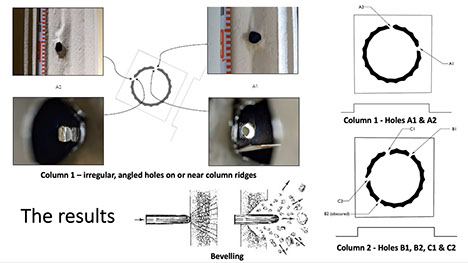
The holes are irregular and not perfectly round. If the holes were made by drilling, I would expect them to be round. The shapes of the holes are more in keeping with an impact and the resulting splintering of wood. The moisture content of the wood would have been a factor.
Very dry wood tends to fragment and splinter more than wood with a high moisture content.
Furthermore, some holes are either on or near the crests of the ribbed surface of the columns. I would expect holes for fittings to be made on the flats between the crests. The random nature of the hole locations in relation to the ribbed surface of the columns also suggest random events as opposed to a planned event.
Holes B1 and B2 are perpendicular to the surface plane of the column. The other holes are all at an angle to the surface plane of the columns. The angles of the holes and the fact that they align, is also strong support for the proposition that they were made by bullets as opposed to tools. I would expect holes made by tools to be at right angles to the surface plane of the columns.
Although the external hole characteristics are covered by paint, there are some characteristics that are still visible. The holes appear to consist of aligned sets and one hole of each set appears to show internal bevelling and the other hole not. Bevelling is a characteristic feature where a bullet exits a perforated frangible surface. This provides strong support for the proposition that each set consists of an entry and exit hole caused by projectiles.
Hole sets B and C appear to have trajectories in the same direction. That is further support for the proposition that they are projectile holes.
Hole sets B and C are at different heights and in approximately the same directions but not vertically aligned. This does not offer any support for planned fittings but rather for shots fired from the same location in the same direction.
There were also some other interesting findings. The endoscope recording, shows a piece of cloth stuck to the inside of Column One. It is a poor image but Andre thinks it is quite possibly a piece of cloth from an item of clothing, a musket ball had passed through a person wearing the clothing.
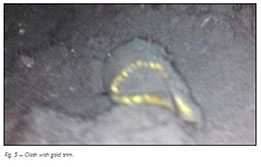
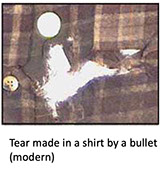 Natalie Raw, a Costume and Textile Curator at Leeds Museum was consulted for her opinion on piece of cloth embedded in Column One. Natalie said the gold trim on the cloth could possibly be gold lace – a kind of gold braiding that was often found on the collars and cuffs of military uniform. We know at least two soldiers – James Daily and John Armstrong were shot during the Uprising. However, Natalie also mentioned that in the 1900s it was not unusual to hide pieces of cloth in buildings to ward off evil spirits. More investigation is certainly needed.
Natalie Raw, a Costume and Textile Curator at Leeds Museum was consulted for her opinion on piece of cloth embedded in Column One. Natalie said the gold trim on the cloth could possibly be gold lace – a kind of gold braiding that was often found on the collars and cuffs of military uniform. We know at least two soldiers – James Daily and John Armstrong were shot during the Uprising. However, Natalie also mentioned that in the 1900s it was not unusual to hide pieces of cloth in buildings to ward off evil spirits. More investigation is certainly needed.
Andre De Villiers Horne’s Summary:
In the absence of definitive evidence such as musket balls and conclusive bullet wipe, Andre states he cannot exclude the possibility that the holes were made by some other means for some other purpose. However, he goes on to say: there is strong support for the proposition that the three sets of holes in Columns 1 and 2 were made by projectiles and that they are unlikely to represent a planned event using tools, such as holes for railings.
The historical and forensic evidence combined provides almost conclusive proof that the Westgate Hotel Bullet Holes were made during the Chartist Rising on 4 November 1839.




